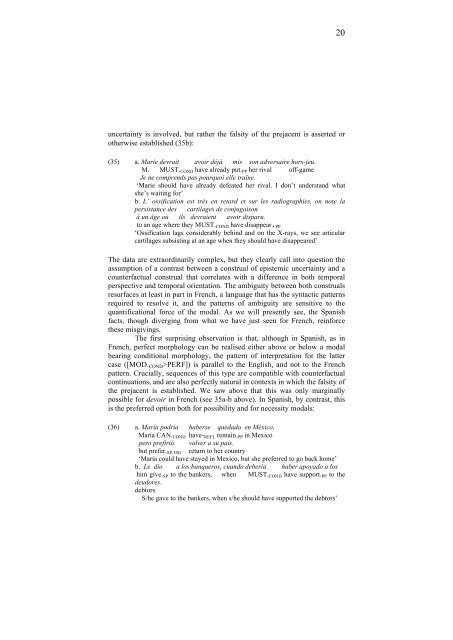On modal tenses and tensed modals - UMR 7023 - CNRS
On modal tenses and tensed modals - UMR 7023 - CNRS
On modal tenses and tensed modals - UMR 7023 - CNRS
You also want an ePaper? Increase the reach of your titles
YUMPU automatically turns print PDFs into web optimized ePapers that Google loves.
uncertainty is involved, but rather the falsity of the prejacent is asserted or<br />
otherwise established (35b):<br />
20<br />
(35) a. Marie devrait avoir déjà mis son adversaire hors-jeu.<br />
M. MUST.COND have already put.PP her rival off-game<br />
Je ne comprends pas pourquoi elle traîne.<br />
‘Marie should have already defeated her rival. I don’t underst<strong>and</strong> what<br />
she’s waiting for’<br />
b. L’ ossification est très en retard et sur les radiographies, on note la<br />
persistance des cartilages de conjugaison<br />
à un âge où ils devraient avoir disparu.<br />
to an age where they MUST.COND have disappear.PP<br />
‘Ossification lags considerably behind <strong>and</strong> on the X-rays, we see articular<br />
cartilages subsisting at an age when they should have disappeared’<br />
The data are extraordinarily complex, but they clearly call into question the<br />
assumption of a contrast between a construal of epistemic uncertainty <strong>and</strong> a<br />
counterfactual construal that correlates with a difference in both temporal<br />
perspective <strong>and</strong> temporal orientation. The ambiguity between both construals<br />
resurfaces at least in part in French, a language that has the syntactic patterns<br />
required to resolve it, <strong>and</strong> the patterns of ambiguity are sensitive to the<br />
quantificational force of the <strong>modal</strong>. As we will presently see, the Spanish<br />
facts, though diverging from what we have just seen for French, reinforce<br />
these misgivings.<br />
The first surprising observation is that, although in Spanish, as in<br />
French, perfect morphology can be realised either above or below a <strong>modal</strong><br />
bearing conditional morphology, the pattern of interpretation for the latter<br />
case ([MOD.COND>PERF]) is parallel to the English, <strong>and</strong> not to the French<br />
pattern. Crucially, sequences of this type are compatible with counterfactual<br />
continuations, <strong>and</strong> are also perfectly natural in contexts in which the falsity of<br />
the prejacent is established. We saw above that this was only marginally<br />
possible for devoir in French (see 35a-b above). In Spanish, by contrast, this<br />
is the preferred option both for possibility <strong>and</strong> for necessity <strong>modal</strong>s:<br />
(36) a. María podría haberse quedado en México,<br />
María CAN.COND have-REFL remain.PP in Mexico<br />
pero prefirió volver a su país.<br />
but prefer.SP.3SG return to her country<br />
‘María could have stayed in Mexico, but she preferred to go back home’<br />
b. Le dio a los banqueros, cu<strong>and</strong>o debería haber apoyado a los<br />
him give.SP to the bankers, when MUST.COND have support.PP to the<br />
deudores.<br />
debtors<br />
S/he gave to the bankers, when s/he should have supported the debtors’

















